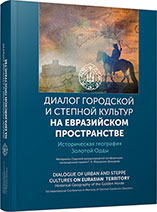Историческая география Среднего Поволжья: вторая половина XIV — первая половина XV в.
Historical Geography of the Middle Volga Region in the Second Half of 14th — First Half of 15th Centuries
Author(s): Ayrat G. Sitdikov
Subject(s): History, Archaeology, Geography, Regional studies, Human Geography, Historical Geography, Environmental Geography, Middle Ages, 6th to 12th Centuries, 13th to 14th Centuries
Published by: Издательский дом Stratum, Университет «Высшая антропологическая школа»
Keywords: Middle Volga region; Golden Horde; administrative division; urban centers; climatic zones
Summary/Abstract: The author discusses features of the Middle Volga region historical development in the second half of the 14th to first half of 15th c., in the Golden Horde decline period. The specificity of the three climatic zones of the Middle Volga region, which determined the economic structure and the originality of the population’s material culture, is taken into account. Following the economic boom and the growing number of urban and rural settlements in the first half of the 14th century, a decline and urban life degradation are traced later, as well as the population migration to the north due to military conflicts and climatic changes. On the other hand, new settlements, cities included, emerged in the Middle Volga in the late 14th to first half of the 15th century as a result of the influx of the Golden Horde servicemen, the Volga Finns and the Russians. In the first half of the 15th century, independent Tatar fiefdoms, or beilyaks are established here, and simultaneously prerequisites for the emergence of independent states — Kasimov and Kazan Khanates — are formed.
Book: Диалог городской и степной культур на Евразийском пространстве. Историческая география Золотой Орды
- Page Range: 135-140
- Page Count: 6
- Publication Year: 2016
- Language: Russian
- Content File-PDF

